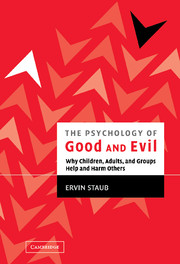Book contents
- Frontmatter
- Contents
- Preface
- Acknowledgments
- PART I INTRODUCTION AND CORE CONCEPTS
- PART II THE ROOTS OF HELPING OTHER PEOPLE IN NEED IN CONTRAST TO PASSIVITY
- PART III HOW CHILDREN BECOME CARING AND HELPFUL RATHER THAN HOSTILE AND AGGRESSIVE
- 10 The Origins of Caring, Helping, and Nonaggression: Parental Socialization, the Family System, and Cultural Influence
- 11 Natural Socialization: The Role of Experience or Learning by Doing
- 12 The Origins of Hostility and Aggression
- 13 Cultural–Societal Roots of Violence: Youth Violence
- 14 Bystanders and Bullying
- 15 Students' Experience of Bullying and Other Aspects of Their Lives in Middle School in Belchertown: Report Summary
- 16 Passive and Active Bystandership across Grades in Response to Students Bullying Other Students
- 17 Self-Esteem and Aggression
- 18 Father–Daughter Incest
- 19 Reducing Boys' Aggression: Learning to Fulfill Basic Needs Constructively
- 20 Creating Caring Schools: Design and Content of a Program to Develop Caring, Helping, Positive Self-Esteem, and Nonviolence
- PART IV THE ORIGINS OF GENOCIDE, MASS KILLING, AND OTHER COLLECTIVE VIOLENCE
- PART V THE AFTERMATH OF MASS VIOLENCE: TRAUMA, HEALING, PREVENTION, AND RECONCILIATION
- PART VI CREATING CARING, MORALLY INCLUSIVE, PEACEFUL SOCIETIES
- Appendix: What Are Your Values and Goals?
- Index
- References
19 - Reducing Boys' Aggression: Learning to Fulfill Basic Needs Constructively
Published online by Cambridge University Press: 07 May 2010
- Frontmatter
- Contents
- Preface
- Acknowledgments
- PART I INTRODUCTION AND CORE CONCEPTS
- PART II THE ROOTS OF HELPING OTHER PEOPLE IN NEED IN CONTRAST TO PASSIVITY
- PART III HOW CHILDREN BECOME CARING AND HELPFUL RATHER THAN HOSTILE AND AGGRESSIVE
- 10 The Origins of Caring, Helping, and Nonaggression: Parental Socialization, the Family System, and Cultural Influence
- 11 Natural Socialization: The Role of Experience or Learning by Doing
- 12 The Origins of Hostility and Aggression
- 13 Cultural–Societal Roots of Violence: Youth Violence
- 14 Bystanders and Bullying
- 15 Students' Experience of Bullying and Other Aspects of Their Lives in Middle School in Belchertown: Report Summary
- 16 Passive and Active Bystandership across Grades in Response to Students Bullying Other Students
- 17 Self-Esteem and Aggression
- 18 Father–Daughter Incest
- 19 Reducing Boys' Aggression: Learning to Fulfill Basic Needs Constructively
- 20 Creating Caring Schools: Design and Content of a Program to Develop Caring, Helping, Positive Self-Esteem, and Nonviolence
- PART IV THE ORIGINS OF GENOCIDE, MASS KILLING, AND OTHER COLLECTIVE VIOLENCE
- PART V THE AFTERMATH OF MASS VIOLENCE: TRAUMA, HEALING, PREVENTION, AND RECONCILIATION
- PART VI CREATING CARING, MORALLY INCLUSIVE, PEACEFUL SOCIETIES
- Appendix: What Are Your Values and Goals?
- Index
- References
Summary
In the past decade, youth violence has increased dramatically in the United States (Blumstein, 1995). This has led to a proliferation of interventions aimed at reducing aggression (Eron, Gentry, & Schlegel, 1994). Both basic research and interventions have focused on boys, who are more physically aggressive. The aim of the present study was to design, implement, and evaluate an intervention that focused on aggressive boys' basic needs, their interpersonal goals, and their ability to fulfill these in a constructive, nonaggressive manner.
Extensive research has shown that reactively aggressive boys lack the cognitive tendencies (see Crick & Dodge, 1994) and social skills (see McFall, 1982) to fulfill their goals in prosocial ways. They tend to interpret the intentions that underlie other's behavior toward them as hostile. This leads them to retaliate against people whose actions are ambiguous and who may mean them no harm (Dodge & Crick, 1990). Aggressive boys tend to have a limited ability to take the perspective of others and to understand what others think and feel (e.g., Pepler, Byrd, & King, 1991). They also see aggression as normal, acceptable behavior (Huesmann & Eron, 1984). It is not surprising, therefore, that in many situations, especially those involving conflict, they become aggressive.
In one promising approach to reducing aggression, children and adolescents receive training in the cognitive and social skills that underlie social behavior (Kazdin, 1994).
Information
- Type
- Chapter
- Information
- The Psychology of Good and EvilWhy Children, Adults, and Groups Help and Harm Others, pp. 252 - 266Publisher: Cambridge University PressPrint publication year: 2003
